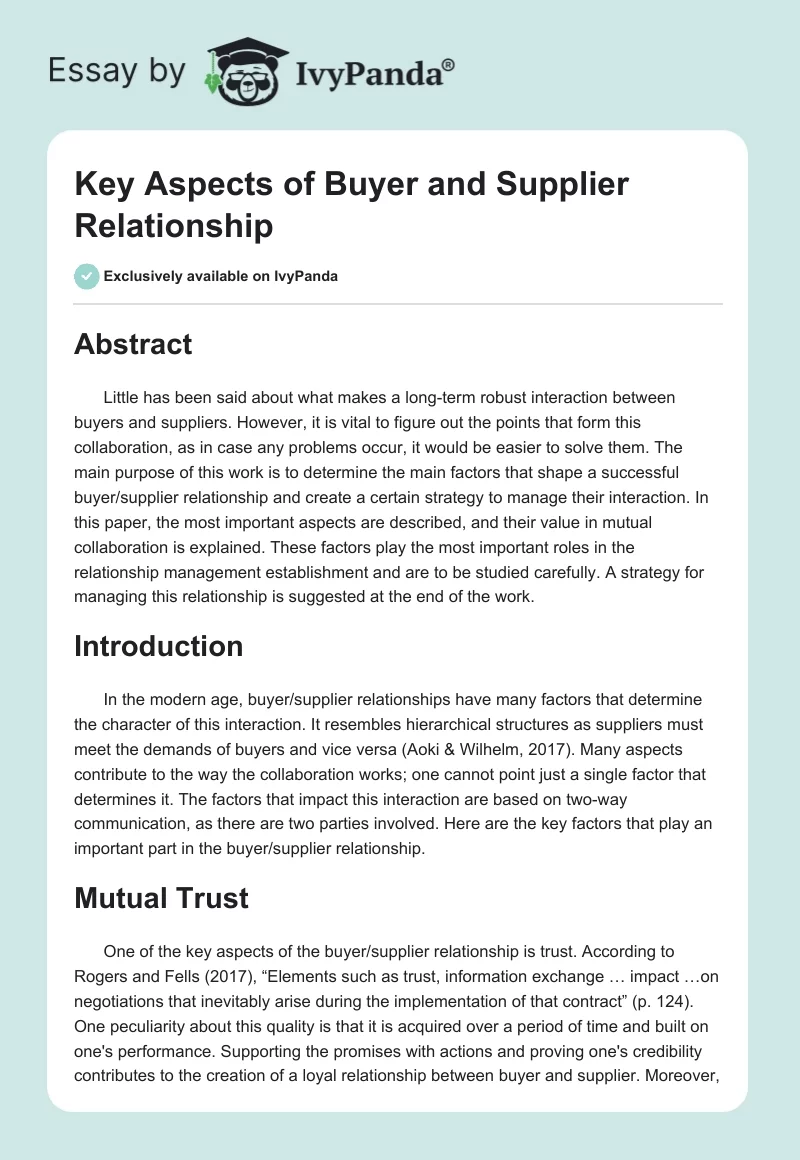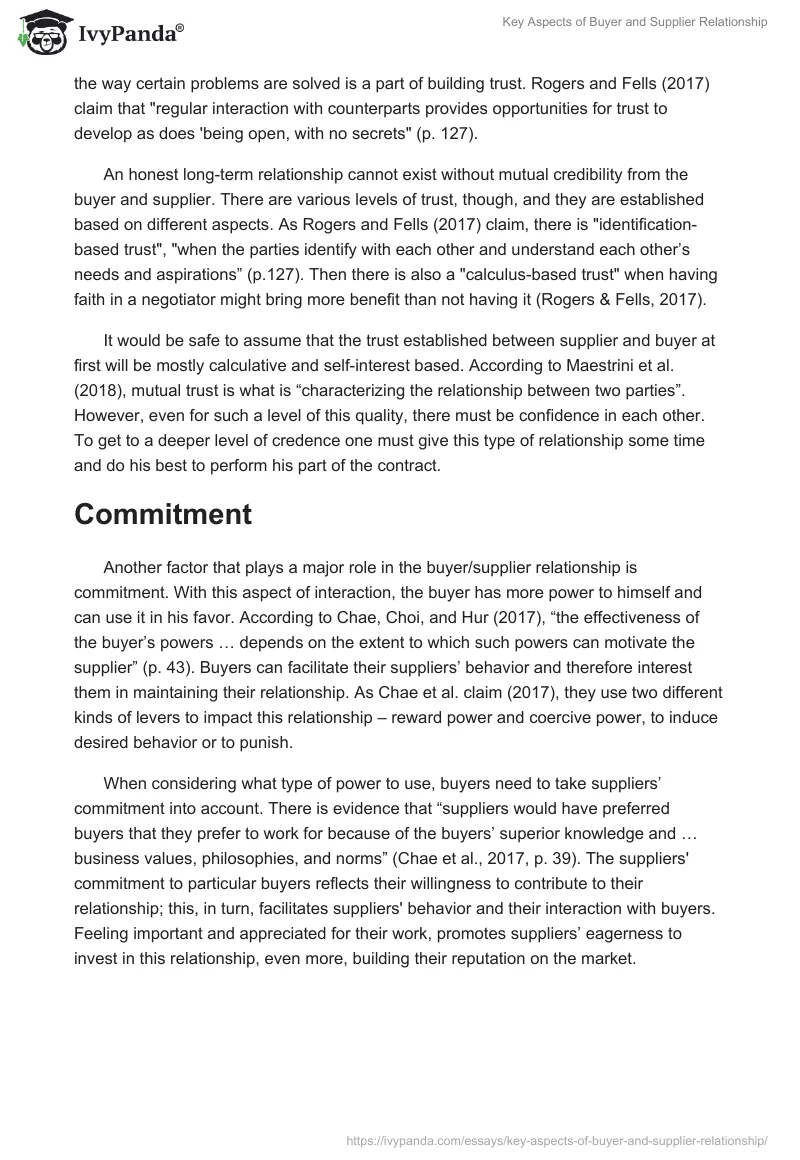Abstract
Little has been said about what makes a long-term robust interaction between buyers and suppliers. However, it is vital to figure out the points that form this collaboration, as in case any problems occur, it would be easier to solve them. The main purpose of this work is to determine the main factors that shape a successful buyer/supplier relationship and create a certain strategy to manage their interaction. In this paper, the most important aspects are described, and their value in mutual collaboration is explained. These factors play the most important roles in the relationship management establishment and are to be studied carefully. A strategy for managing this relationship is suggested at the end of the work.
Introduction
In the modern age, buyer/supplier relationships have many factors that determine the character of this interaction. It resembles hierarchical structures as suppliers must meet the demands of buyers and vice versa (Aoki & Wilhelm, 2017). Many aspects contribute to the way the collaboration works; one cannot point just a single factor that determines it. The factors that impact this interaction are based on two-way communication, as there are two parties involved. Here are the key factors that play an important part in the buyer/supplier relationship.
Mutual Trust
One of the key aspects of the buyer/supplier relationship is trust. According to Rogers and Fells (2017), “Elements such as trust, information exchange … impact …on negotiations that inevitably arise during the implementation of that contract” (p. 124). One peculiarity about this quality is that it is acquired over a period of time and built on one’s performance. Supporting the promises with actions and proving one’s credibility contributes to the creation of a loyal relationship between buyer and supplier. Moreover, the way certain problems are solved is a part of building trust. Rogers and Fells (2017) claim that “regular interaction with counterparts provides opportunities for trust to develop as does ‘being open, with no secrets” (p. 127).
An honest long-term relationship cannot exist without mutual credibility from the buyer and supplier. There are various levels of trust, though, and they are established based on different aspects. As Rogers and Fells (2017) claim, there is “identification-based trust”, “when the parties identify with each other and understand each other’s needs and aspirations” (p.127). Then there is also a “calculus-based trust” when having faith in a negotiator might bring more benefit than not having it (Rogers & Fells, 2017).
It would be safe to assume that the trust established between supplier and buyer at first will be mostly calculative and self-interest based. According to Maestrini et al. (2018), mutual trust is what is “characterizing the relationship between two parties”. However, even for such a level of this quality, there must be confidence in each other. To get to a deeper level of credence one must give this type of relationship some time and do his best to perform his part of the contract.
Commitment
Another factor that plays a major role in the buyer/supplier relationship is commitment. With this aspect of interaction, the buyer has more power to himself and can use it in his favor. According to Chae, Choi, and Hur (2017), “the effectiveness of the buyer’s powers … depends on the extent to which such powers can motivate the supplier” (p. 43). Buyers can facilitate their suppliers’ behavior and therefore interest them in maintaining their relationship. As Chae et al. claim (2017), they use two different kinds of levers to impact this relationship – reward power and coercive power, to induce desired behavior or to punish.
When considering what type of power to use, buyers need to take suppliers’ commitment into account. There is evidence that “suppliers would have preferred buyers that they prefer to work for because of the buyers’ superior knowledge and … business values, philosophies, and norms” (Chae et al., 2017, p. 39). The suppliers’ commitment to particular buyers reflects their willingness to contribute to their relationship; this, in turn, facilitates suppliers’ behavior and their interaction with buyers. Feeling important and appreciated for their work, promotes suppliers’ eagerness to invest in this relationship, even more, building their reputation on the market.
Interdependence
As the relationship involves two parties, it is only fair that both of them get want they want out of this collaboration. According to Soh, Jayaraman, Yen, and Kiumarsi (2016), “benefits are … created in the relationships between these … parties”. Not only buyers have the power in this interaction: suppliers have it too, it is just a different type of it. It has been proved that successful competitive suppliers have the luxury to choose the buyers to collaborate with (Soh, et al., 2016, p. 186). Being the providers they are suppliers have buyers at their mercy. Soh, et al. claim (2016), that “to balance out the power of suppliers, a proper supplier management system needs to be in place”.
The research shows that that will “ensure proper, healthy and well-balanced relationship exists between these two parties” (Soh, et al., 2016, p. 186). Being dependent on each other, buyers and suppliers need structure in their interaction so that no one starts to abuse their power and disturb the balance of the relationship. It is important to note, that eagerness to work as a team and share all the risks “allows benefits to be achieved … in quality, delivery, … product development, and problem solving” (Soh, et al., 2016, p. 186).
Strong interdependence promotes a cohesive relationship between the two parties. Achieving their goals through successful collaboration with each other makes for a long-term buyer/supplier relationship. Being equally involved in strive for reaching those goals is what fuels this collaboration and sets it to work effectively. As one party’s success depends on another one’s and vice versa, both buyer and supplier will try to do their best to ensure the outcome’s progress.
Strategy for managing the relationship
If managed smartly, the buyer/supplier collaboration can be successful and productive in the long-term specter. Minimizing the probability of any type of conflict is the main goal in the buyer/supplier management. The research shows that “more activity and communication between buyer and supplier establishes and enhances trust” (Yang et al., 2017, p. 154). Mutual trust is, perhaps, the most important factor in this type of relationship, and altering it for the better would only benefit the success of the collaboration.
It also has to be mentioned “that managers should strive to build and maintain dyadic trust, though this is difficult and costly to maintain” (Yang et al., 2017, p. 154). According to Yang, et al. (2017), “control mechanisms (… contract, asset specificity, trust, or relational norms) are the necessary… effective tools used to manage buyer-supplier conflict” (p. 146).
It has been stated that beyond the aforementioned factors, the strategy should include open two-way communication, objective performance management, investment in mutual activities and cooperation (Rogers & Fells, 2017). According to the research, where several respondents took part, one of them mentioned that “both buyer and seller worked jointly to address a technical problem” (Rogers & Fells, 2017). He went on adding that “everyone on the project worked hard and … showed … appreciation” and due to that a relationship with the supplier was built (Rogers & Fells, 2017).
Sharing the information needed for collaboration between buyers and suppliers is crucial for relationship management, as both parties will feel equally involved and important in this capacity. There will be no imbalance of power and therefore no abuse of it either. Evaluating one’s performance in this relationship is just as necessary: careful depiction of the contract fulfillment by both parties will give the full picture of how they do their job. In case any conflicts occur, that evaluation can be used as a lever to manage the buyer/supplier relationship.
Conclusion
Introducing the abovementioned factors into one’s management system to facilitate the buyer/supplier relationship is a win-win. It will boost the motivation for the workers to do their jobs more effectively and will up the performance of the company in general. It will help to establish long-term collaborations between buyers and suppliers and ensure that these interactions will bring benefits to both sides. Smartly using the levers that were mentioned in the paper one may reduce the number of potential conflicts in this relationship to zero.
References
Aoki, K., & Wilhelm, M. (2017). The role of ambidexterity in managing buyer-supplier relationships: The Toyota case. Organization Science, 28(6), 1080-1097.
Chae, S., Choi, T. Y., & Hur, D. (2017). Buyer power and supplier relationship commitment: A cognitive evaluation theory perspective. Journal of Supply Chain Management, 53(2), 39-60.
Maestrini, V., Martinez, V., Neely, A., Luzzini, D., Caniato, F., & Maccarrone, P. (2018). The relationship regulator: a buyer-supplier collaborative performance measurement system. International Journal of Operations & Production Management.
Rogers, H., & Fells, R. (2017). Successful buyer-supplier relationships: The role of negotiations. Journal of Strategic Contracting and Negotiation, 3(3), 121-136.
Soh, K. L., Jayaraman, K., Yen, T. S., & Kiumarsi, S. (2016). The role of suppliers in establishing a buyer-supplier relationship towards better supplier performance. International Journal of Productivity and Quality Management, 17(2), 183-197.
Yang, W., Gao, Y., Li, Y., Shen, H., & Zheng, S. (2017). Different roles of control mechanisms in buyer-supplier conflict: An empirical study from China. Industrial Marketing Management, 65, 144-156.


